Spaghetti cacio e pepe is an amazing Italian pasta dish made with just 2 main ingredients: pecorino cheese and black pepper. It’s very quick to make and so flavorful!
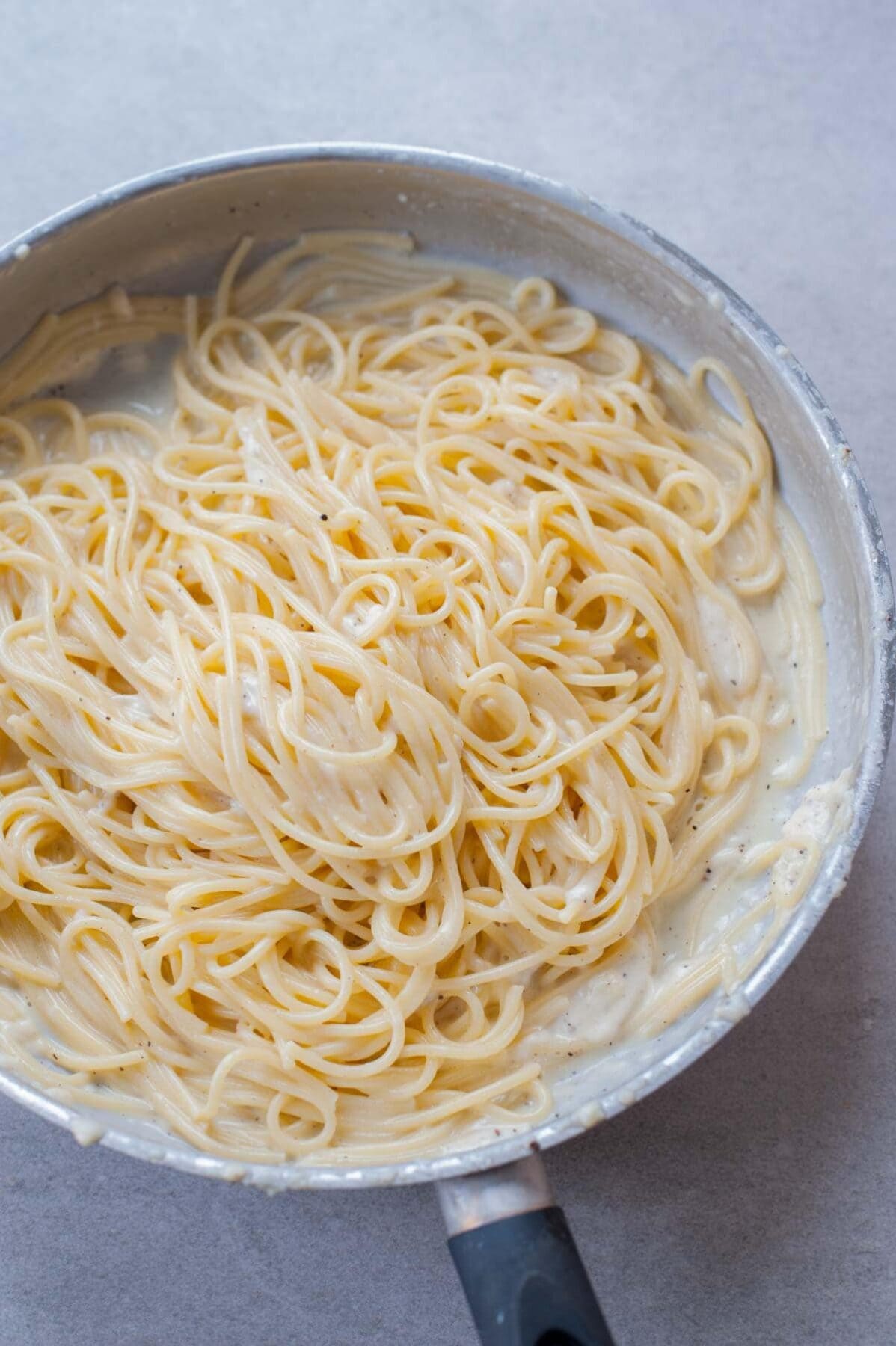
What is cacio e pepe:
Cacio e pepe is a Roman dish that is made with just 3 ingredients: pasta, Pecorino Romano cheese, and ground black pepper.
What does cacio e pepe mean? Cacio means Pecorino cheese in the Roman dialect, and the pepe means just pepper.
This is a very simple recipe but unfortunately, it doesn’t mean just combining pasta with cheese and pepper. The goal is to get creamy, smooth cheese sauce, not clumps of cheese that won’t melt.
I tested all the possible ingredients ratios and different preparation methods to get you the best possible, foolproof recipe that always works.
Ingredients:
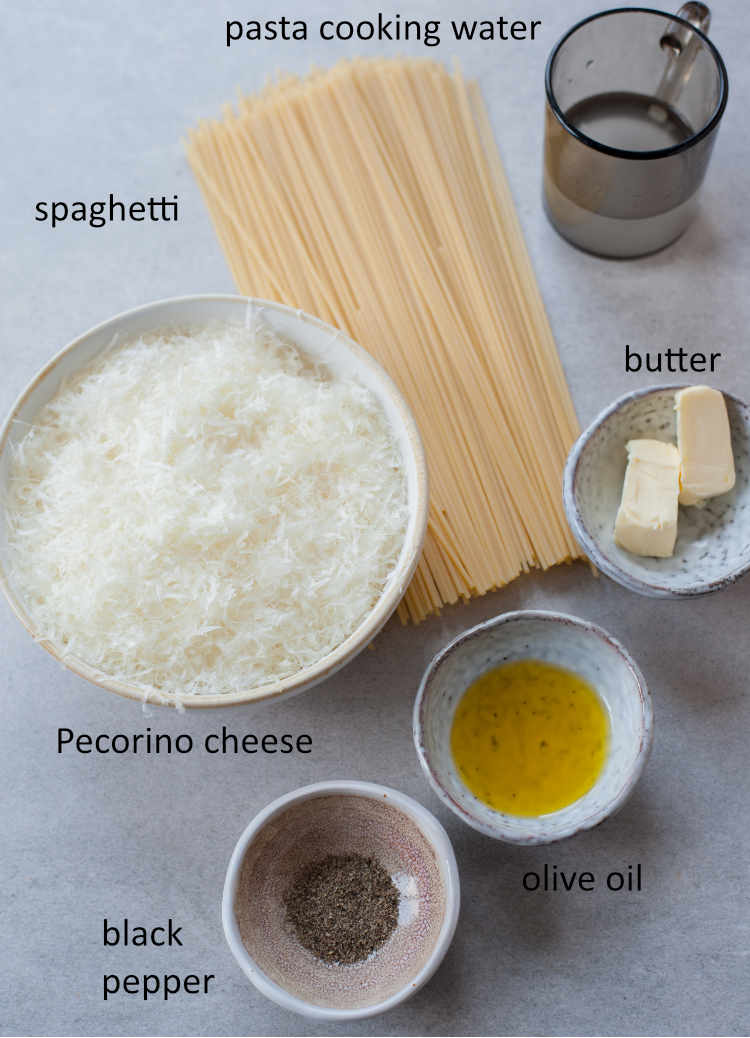
Pasta:
The best pasta for this recipe is spaghetti. You can also use any other type of long and thin pasta, like bucatini. The most traditionally used pasra is tonnarelli. Pici pasta (short, very thick spaghetti) is often used in Tuscany. I wouldn’t recommend thick short pasta like penne or fusilli.
Cheese:
For this recipe you’ll need an Italian cheese called Pecorino. Pecorino is a very flavorful, sharp cheese made from sheep’s milk.
What kind of pecorino cheese is best for cacio e pepe? There are many kinds of pecorino cheese and choosing the right one may make or brake the dish!
- Age of the Pecorino cheese: The most important thing when choosing the right Pecorino cheese is that it must be aged (it’s labeled Pecorino stagionato) – it’s a hard and crumbly cheese. If the cheese is not properly labeled (this sometimes happens for me at the deli counter) just press the cheese with your finger. The cheese should be completely hard, like a block of Parmesan cheese, you should not be able to make an indentation in it. Young or semi-stagionato cheeses are not suitable for this recipe! They have a softer texture and milder, creamy flavor.
- The second important thing is the type of Pecorino. There are a couple of types of Pecorino cheese depending on where it’s produced. There’s Pecorino Romano, Pecorino Toscano, Pecorino Sardo or Pecorino Siciliano. The most authentic cheese for cacio e pepe is Pecorino Romano (since it’s a Roman dish) but my personal preference is to use aged Pecorino Toscano cheese. I tried this dish with other types of Pecorino and didn’t like it.
What is the difference between Pecorino Romano and Pecorino Toscano cheese? Pecorino Romano is very salty and has a more intense flavor. Pecorino Toscano is more mild (but still very very flavorful) and less salty. When making the cacio e pepe with Pecorino Romano some of my taste testers complained that it is too salty, although I didn’t add any salt to the dish (besides salting the pasta water of course). If this is also the case for you, you can swap 1/3 of the Pecorino Romano cheese for Parmesan cheese (Parmigiano-Reggiano) or just use Pecorino Toscano!
Can I use Parmesan instead of Pecorino? I wouldn’t recommend substituting Parmesan (Parmigiano-Reggiano) cheese for Pecorino cheese. Both types of cheese are similar, they are both aged, hard kinds of cheese, but Parmesan is made from cow’s milk and has a much milder flavor than Pecorino. If the Pecorino Romano is too salty for you, you can sub 1/3 of its amount for Parmesan cheese to reduce the saltiness but still retain amazing, strong cheese flavor.
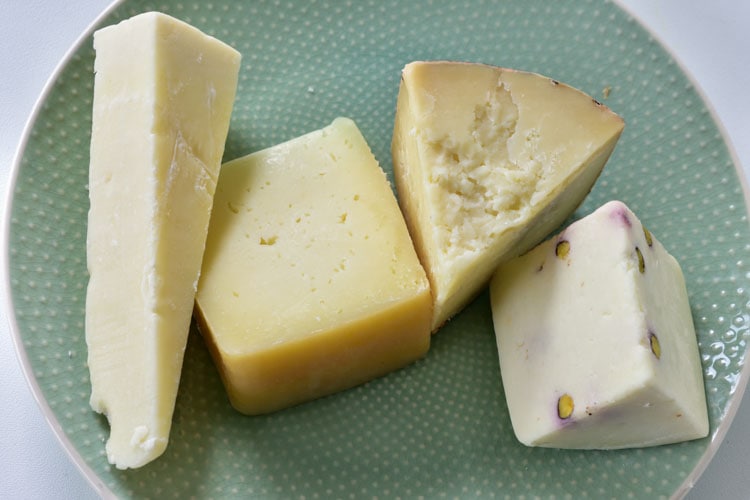
Pepper:
Since this is one of the two main ingredients of this recipe, make sure to use freshly ground black pepper. You can grind your pepper in a pepper mill or using a pestle and mortar – this produces a more coarsely ground pepper.
How much pepper do you need: I like to add about 1 teaspoon of pepper when using Pecorino Romano cheese and 2 teaspoons of pepper when using Pecorino Toscano (this cheese has a milder taste you can use more pepper). You can add less at first and always add more at the end. The amount of pepper may be different depending how coarse you’ve ground your pepper.
Additionally:
- Pasta cooking water – contains starch, which helps thicken the sauce. Don’t forget to reserve it!
- Butter and olive oil – these two ingredients are not used in traditional cacio e pepe recipes. I’ve found that toasting the pepper in oil makes it so much flavorful and the whole dish tastes just better (what doesn’t taste better with butter?!).
Recipe variations:
- Lemon arugula cacio e pepe – it’s a very popular recipe from Chrissy Teigen. I’ve tried it and it was good but I prefer this dish without any additions. It’s really perfect as it is. If you want to try it, though, after toasting the pepper in butter and olive oil, add zest grated from 1/2 lemon and 1 teaspoon of lemon juice, then at the end of preparing this dish, when the cheese sauce is created, stir in a handful of baby arugula leaves.
- Add more seasonings – for example chili flakes or garlic.
- Add some veggies or protein – you can use this recipe as a base for other dishes and add some sauteed veggies or chicken/shrimps to it.
How to make cacio e pepe step by step:
This is a very simple recipe but the one thing that could go wrong is that your cheese refuses to melt and you will end up with a greasy clumpy mess that won’t taste so good. Because of that, a good technique is really important with this recipe so try to follow my instructions exactly to enjoy a perfectly smooth and delicious sauce!
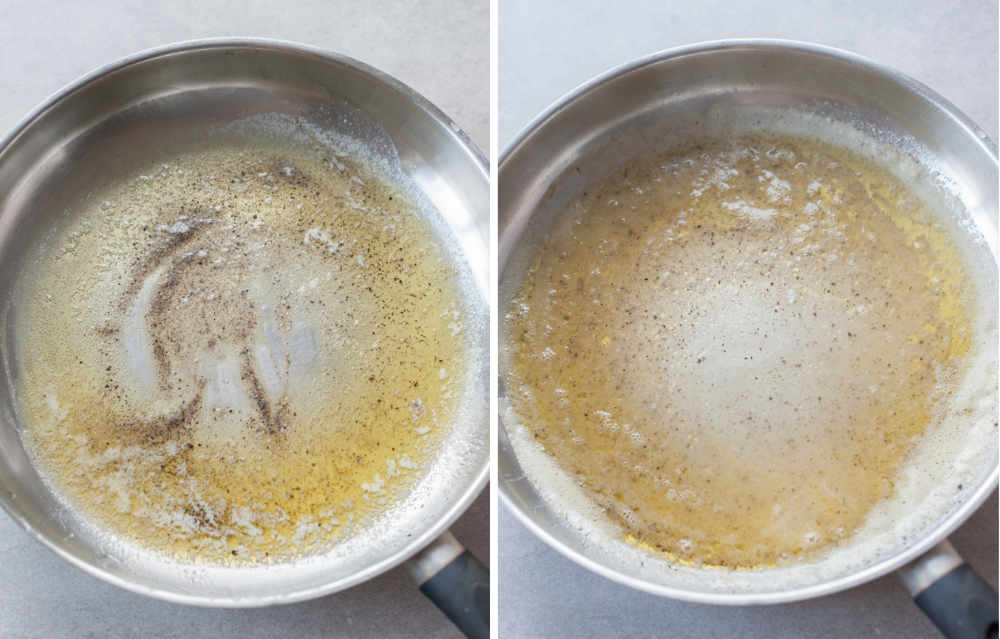
STEP 1: Start with cooking the pasta – it’s important that it’s cooked al dente – it means it should have a bite to it. The pasta can’t be overcooked or it will ruin the dish. The other important thing when cooking the pasta is to cook it in a small amount of water – just enough to cover the pasta. We will need pasta cooking water for the cheesy sauce so the less water you use for cooking your pasta the more starchy it will be. This starchy pasta cooking water will thicken the cheese sauce. The water should be also well-salted – this is an important rule when cooking any pasta type for any kind of pasta dish – the noodles itself must be seasoned to taste good.
Cook the pasta about 1-2 minutes less than it says on the package, because it will be cooked later in the pan with the sauce.
STEP 2: While the pasta is cooking, grate the cheese. First of all, grate the cheese yourself. Pre-grated cheeses have some substances added to them which prevents them from fully melting. Second of all, grate the cheese on very small holes a box grater, or for the best results – on a microplane. Grating the cheese on the microplane yields the best results – finely grated cheese melts more easily and quickly.
STEP 3: Toast the pepper in olive oil and butter – it intensifies its flavor: heat the butter and olive oil in a pan over medium-low heat. When hot, add the ground pepper and cook, stirring, for about a minute or until the pepper is very fragrant. Take the pan off the heat.
STEP 4: Add the pasta cooking water: about 3 minutes before the end of the cooking time reserve about 1 cup of pasta cooking water. We will need only 1/2 cup for this recipe but it’s always good to have more on hand if you need to dilute the sauce. Don’t reserve the pasta cooking water too early or it won’t be starchy enough. Now, add the 1/2 cup of the water to the pan and whisk intensively to combine it with butter and olive oil. Set aside.
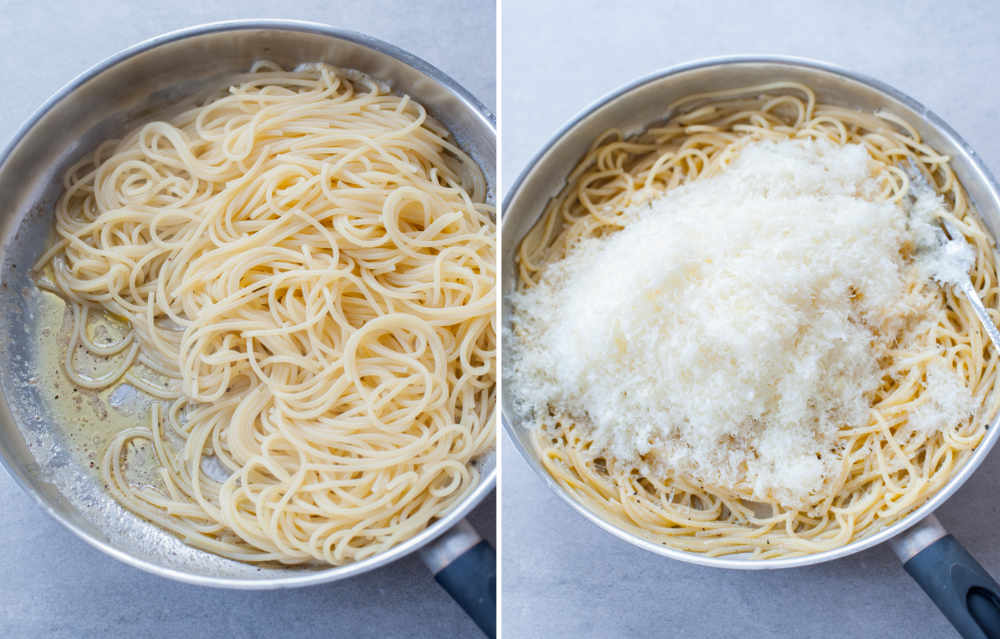
STEP 5: Add the cooked pasta to the pan and toss it with the sauce. Let stand for about a minute or two, letting it cool before adding slightly the cheese.
STEP 6: Now add the cheese and stir very intensively with kitchen tongs or two forks until the cheese is melted, creamy, and creates a smooth silky sauce. You can put the pan on the burner while you do this and heat it over low heat to help melt the cheese. If the cheese doesn’t melt easily add some more reserved pasta cooking water. Heat the sauce gently over low heat until all the cheese is melted.
That’s it! Your cacio e pepe is ready to devour! Enjoy.
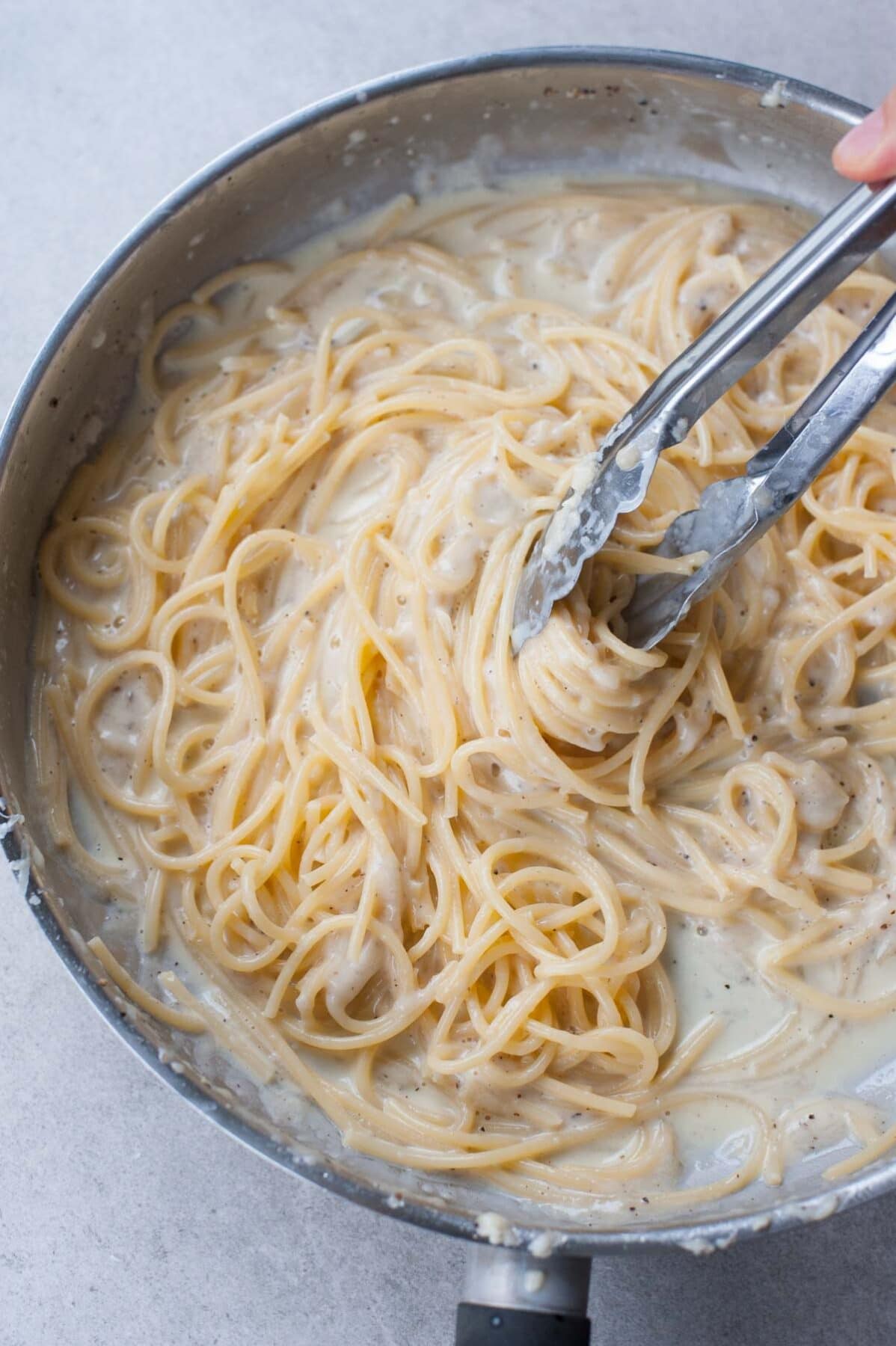
The most important tips and tricks that may make or break the recipe:
- Cook the pasta correctly – don’t overcook it, the water should be well-salted, stir the pasta frequently at the beginning not letting it stick, don’t add any oil to the pasta while it cooks.
- Use freshly ground pepper.
- Toast the pepper in olive oil and butter for maximum flavor.
- Choose the right cheese – make sure it’s aged. The best in my opinion is aged Pecorino Toscano or Pecorino Romano. Don’t swap the Pecorino for Parmesan (you can swap 1/3 of the Pecorino without losing lots of flavor, if the Pecorino Romano is too salty for you).
- Make sure to grate the cheese yourself. Grate it on the smallest holes of a box grater or better – on the microplane grater – this is really important, I’ve never had a clumpy sauce when I grated the cheese on the microplane. The cheese melts more easily when it’s at room temperature.
- Don’t add the cheese to the hot pasta or pasta cooking water – let is stand for a while and cool then stir it with the cheese.
- Adjust the sauce consistency – if it’s too thick add some more pasta cooking water if it’s too thick, cook it just a little longer.
- Don’t mistake clumpy cheese with cheese that is not melted yet – just heat it slowly over low heat, stir constantly adding a little more pasta cooking water until the cheese is melted.
How to serve cacio e pepe:
- You can serve it as an appetizer.
- You can serve it as a part of the main dish. Serve it for example with this baked lemon thyme chicken breast.
- Serve it with bread and salad, for example, with this cucumber avocado tomato salad with dill and feta.
Other preparation methods:
Traditional method: traditionally cacio e pepe is prepared very simply. Pasta is cooked then tossed with grated cheese, ground pepper, and some pasta cooking water. My recipe adds one more step – cooking the pepper with butter and olive oil. It really adds more flavor to the dish.
Food processor method: there is also another method of preparation cacio e pepe – the sauce is made in a food processor. I’ve read about it on the Smitten Kitchen blog. It’s also a great way to make this dish. This method omits cooking the pepper with butter and olive oil which for me really makes a difference in flavor, so I would add this step anyway. How to do it: cook the pasta al dente, reserve some pasta cooking water. Toast the pepper in olive oil and butter, leave to cool then add to a food processor along with the grated cheese and a tablespoon of cold water. Mix until a smooth sauce is created. Combine with cooked spaghetti, add some pasta cooking water to dilute the sauce. Enjoy!
FAQ:
Possible reasons: you’ve used pre-grated cheese (this type of cheese doesn’t melt well), the cheese was too coarsely grated, the pasta or pasta cooking water was too hot (you didn’t let it cool down enough).
Yes the sauce can be reheated. Warm it up gently over low heat until it’s melted again. Store the sauce in the fridge for up to 3 days. The noodles won’t be unfortunately as firm (al dente) as freshly cooked.
Other quick pasta dishes you may enjoy:
- Pasta Primavera (spring vegetable creamy lemon pasta)
- Shrimp pesto pasta with zucchini
- Pasta alla Norma – tomato and eggplant pasta recipe
- Chicken with cheese sauce and broccoli
- Chicken zucchini pasta with creamy lemon garlic sauce
- Tuna pasta with tomatoes and olives
- Fish with gorgonzola spinach and lemon pasta
- Pasta Caprese – tomatoes, mozzarella, and basil pasta
- Spaghetti alla Puttanesca – tomatoes, olives, capers and anchovies pasta
- Gorgonzola Walnut Pasta
Spaghetti cacio e pepe
składniki
- 9 oz (250g) spaghetti
- 5 oz (135g) Pecorino cheese, aged Pecorino Toscano or Pecorino Romano cheese
- 1/2 cup pasta cooking water it’s good to have more on hand
- 1 tablespoon butter
- 1 tablespoon olive oil
- 1-2 teaspoons freshly ground black pepper
Would you like to save this?
wykonanie
- Prepare all the ingredients: grate the cheese on the microplane zester (it's the best) or on the smallest holes of a box grater, grind the pepper. Set aside.
- Toast the pepper: Heat the olive oil and butter in a big frying pan over low heat. When the oil and butter are hot, add the pepper. Cook, stirring, for about a minute or until the pepper is fragrant. Take the pan off the heat.
- Cook the pasta: In a medium pot bring water to the boil. Water should be well-salted, don't add any oil to the water, use the smallest amount of water that will cover the pasta. Cook the pasta about 1-2 minutes less than it says on the package.
- Reserve the pasta cooking water: About 3 minutes before the end of the cooking time reserve about 1 cup of pasta cooking water. We will need only 1/2 cup for this recipe but it's always good to have more on hand if you need to dilute the sauce.
- Add the 1/2 cup of the water to the pan and whisk intensively to combine it with butter and olive oil. Set aside. Reserve the remaining pasta cooking water.
- Add the cooked pasta to the pan and toss it with the sauce. Let stand for about a minute or two, letting it cool slightly before adding the cheese.
- Add the cheese and stir very intensively with kitchen tongs or two forks until the cheese is melted, creamy, and creates a smooth silky sauce. You can put the pan on the burner while you do this and heat it over very low heat to help melt the cheese. If the cheese doesn't melt easily add some more reserved pasta cooking water. Heat the sauce gently over low heat until all the cheese is melted.
- Taste the pasta and season with more pepper if necessary.
- Serve immediately!
uwagi
- How much pepper to add: I like to add about 1 teaspoon of pepper when using Pecorino Romano cheese and 2 teaspoons of pepper when using Pecorino Toscano (this cheese has a milder taste you can use more pepper). You can add less at first and always add more at the end. The amount of pepper may be different depending on how coarse you’ve ground your pepper.
- 5 oz (135g) Pecorino cheese is about 2 1/2 cups cheese grated on a microplane or 1 1/2 cups cheese grated on the small holes of a box grater. Microplane zester works best for this recipe.
- Choose the right cheese: My personal favorite is aged Pecorino Toscano cheese, the second one (and more authentic) is aged Pecorino Romano. Make sure to use an aged cheese (labeled stagionato) and not softer varieties. If the cheese is not properly labeled just press the cheese with your finger. The cheese should be completely hard, like a block of Parmesan cheese, you should not be able to make an indentation in it. If the Pecorino Romano is too salty for you, you can sub 1/3 of its amount for Parmesan cheese or just use Pecorino Toscano. Parmesan cheese can be theoretically used in this recipe as a substitution of Pecorino cheese but the dish will taste very different.
- Using butter and olive oil is not traditional. You can omit toasting the pepper with oil if you wish but I find it adds lots of flavor to the recipe.
- Don’t add the cheese to hot pasta or pasta cooking water or it will clump.
- Calories = 1 serving (1/2 of the recipe). This is only an estimate!
Did you make this recipe? RATE THE RECIPE or tell me in the COMMENTS how you liked it! You can also add a photo of your dish. It would make me very happy and will help other readers. Thank you!!

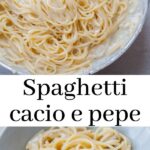
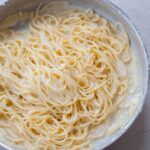
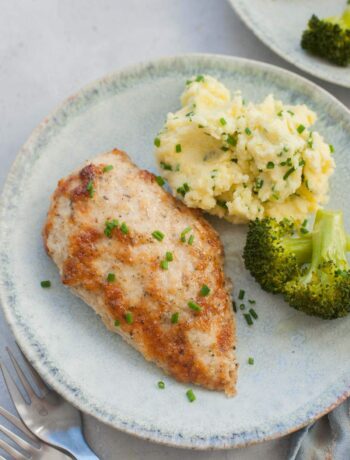

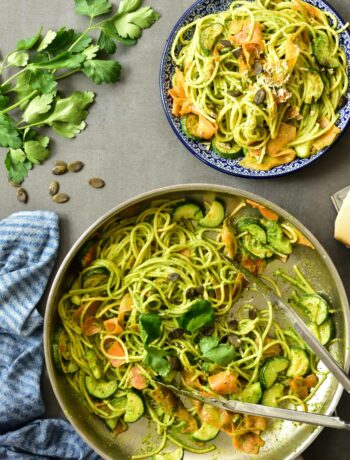
2 komentarze
Christina
18 kwietnia 2021 o 18:40This was absolutely delicious! I used Trader Joe’s Toscano cheese with black pepper and it was creamy and balanced with the perfect amount of pepper. I have since experimented with other cheeses but this one is my favorite. It wasn’t clumpy at all, it was very rich and comforting. Thank you for posting.
Aleksandra
18 kwietnia 2021 o 19:05Thank you so much for the review – I’m glad you liked it!